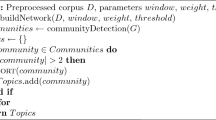Abstract
Clustering, as an unsupervised learning method and an important process in data mining, is an aspect of large and distributed data analysis. In many applications, such as peer-to-peer systems, huge volumes of data are distributed between multiple sources. Analysis of these volumes of data and identifying appropriate clusters is challenging due to transmission, processing and storage costs. In this paper, a gossip-based distributed clustering algorithm for P2P networks called Efficient GBDC-P2P is proposed, based on an improved gossip communicative approach by combining the peer sampeling and CYCLON protocol and the idea of partitioning-based data clustering. This algorithm is appropriate for data clustering in unstructured P2P networks, and it is adapted to the dynamic conditions of these networks. In the Efficient GBDC-P2P algorithm, distributed peers perform clustering operation in a distributed way only through local communications with their neighbors. Our approach does not rely on the central server to carry out data clustering task and without the need to synchronize operations. Evaluation results verify the efficiency of our proposed algorithm for data clustering in unstructured P2P networks. Furthermore, comparative analyses with other well-established distributed clustering approaches demonstrate the superior accuracy of the proposed method.



















Similar content being viewed by others
References
Lodi S, Moro G, Sartori C (2010) Distributed data clustering in multi-dimensional peer-to-peer networks. In: ADC, pp 171–178
Mashayekhi H, Habibi J, Voulgaris S, van Steen M (2013) GoSCAN: decentralized scalable data clustering. Computing 95(9):759–784
Schollmeier R (2001) A definition of peer-to-peer networking for the classification of peer-to-peer architectures and applications. In: Proceedings of the IEEE international conference on peer-to-peer computing, Linköping, Sweden
Mashayekhi H, Habibi J, Khalafbeigi T, Voulgaris S, van Steen M (2015) GDCluster: a general decentralized clustering algorithm. IEEE Trans Knowl Data Eng 27(7):1892–1905
Yang M, Yang Y (2008) An efficient hybrid peer-to-peer system for distributed data sharing. In: Proceedings of the 22nd IEEE international parallel and distributed processing symposium, Miami
Samatova NF, Ostrouchov G, Geist A, Melechko AV (2002) RACHET: an efficient cover-based merging of clustering hierarchies from distributed datasets. Distrib Parallel Databases 11(2):157–180
Merugu S, Ghosh J (2003) Privacy-preserving distributed clustering using generative models. In: Proceedings of the third IEEE international conference on data mining (ICDM’03), pp 211–218
Da Silva J, Giannella C, Bhargava R, Kargupta H, Klusch M (2005) Distributed data mining and agents. Eng Appl Artif Intell 18(7):791–807
Hammouda KM, Kamel MS (2009) Hierarchically distributed peer-to-peer document clustering and cluster summarization. IEEE Trans Knowl Data Eng 21(5):681–698
Januzaj E, Kriegel H-P, Pfeifle M (2004) Scalable density-based distributed clustering. In: 8th European conference on principles and practice of knowledge discovery in databases, Springer, Berlin, pp 231–244
Hammouda KM, Kamel MS (2014) Models of distributed data clustering in peer-to-peer environments. Knowl Inf Syst 38(2):303–329
Klusch M, Lodi S, Moro G (2003) Agent-based distributed data mining: the KDEC scheme. In: Proceedings of the AgentLink, pp 104–122
Datta S, Bhaduri K, Giannella C, Wolff R, Kargupta H (2006) Distributed data mining in peer-to-peer networks. IEEE Internet Comput Spec Issue Distrib Data Min 10(4):18–26
Park B, Kargupta H (2003) Distributed data mining: algorithms, systems, and applications. In: Ye N (ed) The Handbook of Data Mining. Lawrence Erlbaum Associates, pp 341–358
Eisenhardt M, Muller W, Henrich A (2003) Classifying documents by distributed P2P clustering. Proc GI Jahrestag 2(35):286–291
MacQueen JB (1967) Some methods for classification and analysis of multivariate observations.In: Proceedings of 5th Berkeley symposium on mathematical statistics and probability, Berkeley, Calif., University of California Press, vol 1, pp 281–297
Datta S, Giannella C, Kargupta H (2006) K-means clustering over a large, dynamic network. In: Proceedings of the SIAM international conference on data mining, pp 153–164
Datta S, Giannella CR, Kargupta H (2009) Approximate distributed K-means clustering over a peer-to-peer network. IEEE Trans Knowl Data Eng 21(10):1372–1388
Ester M, Kriegel HP, Sander J, Xu X (1996) A density-based algorithm for discovering clusters in large spatial databases with noise. In: Proceedings of knowledge discovery in database (KDD), pp 226–231
Di Fatta G, Blasa F, Cafiero S, Fortino G (2013) Fault tolerant decentralised K-means clustering for asynchronous large-scale networks. J Parallel Distrib Comput 73(3):317–329
Kaufman L, Rousseeuw PJ (1987) Clustering by means of medoids. In: Dodge Y (ed) Statistical data analysis based on the L1-norm and related methods. North-Holland, Amsterdam, pp 405–416
Voulgaris S, Gavidia D, van Steen M (2005) CYCLON: inexpensive membership management for unstructured P2P overlays. J Netw Syst Manag 13:197–217
Azimi R, Sajedi H (2014) Persistent K-means: stable data clustering algorithm based on K-means algorithm. J Comput Robot 7:57–66
Xu W, Liu X, Gong Y (2003) Document clustering based on non-negative matrix factorization. In: Proceedings of the international conference on research and development in information retrieval, pp 267–273
Ruspini EH (1969) A new approach to clustering. Inf Control 15(1):22–32
UCI machine learning repository. https://archive.ics.uci.edu/ml/datasets.html
Pena JM, Lozano JA, Larraiiaga P (1999) An empirical comparison of the initialization methods for the K-means algorithm. Pattern Recognit Lett 20(10):1027–1040
Bradley PS, Fayyad UM (1998) Refining initial points for K-means clustering. In: ICML ‘98 Proceedings of the fifteenth international conference on machine learning, pp 91–99
Barakbah AR, Kiyoki Y (2009) A pillar algorithm for K-means optimization by distance maximization for initial centroid designation. In: The IEEE symposium on computational intelligence and data mining, Nashville
Bhusare BB, Bansode SM (2014) Centroids initialization for K-means clustering using improved pillar algorithm. Int J Adv Res Comput Eng Technol (IJARCET) 3(4):1317–1322
Tzortzis G, Likas A (2014) The MinMax K-means clustering algorithm. Pattern Recognit 47(7):2505–2516
Hubert L, Arabie P (1985) Comparing partitions. J Classif 2(1):193–218
Author information
Authors and Affiliations
Corresponding author
Rights and permissions
About this article
Cite this article
Azimi, R., Sajedi, H. Peer sampling gossip-based distributed clustering algorithm for unstructured P2P networks. Neural Comput & Applic 29, 593–612 (2018). https://doi.org/10.1007/s00521-017-3119-0
Received:
Accepted:
Published:
Issue Date:
DOI: https://doi.org/10.1007/s00521-017-3119-0




